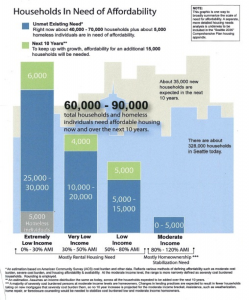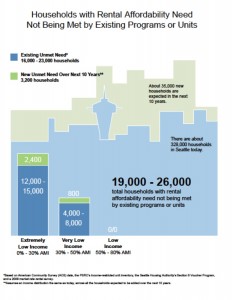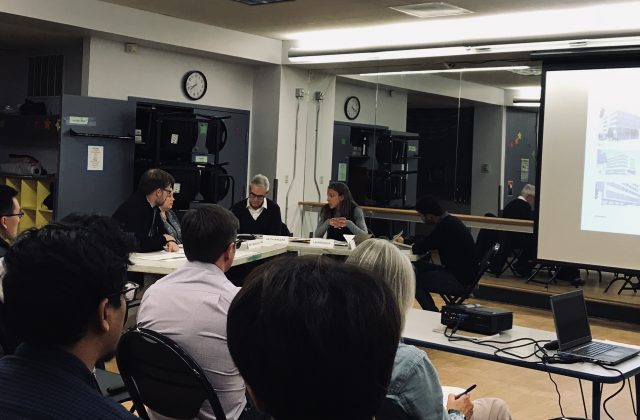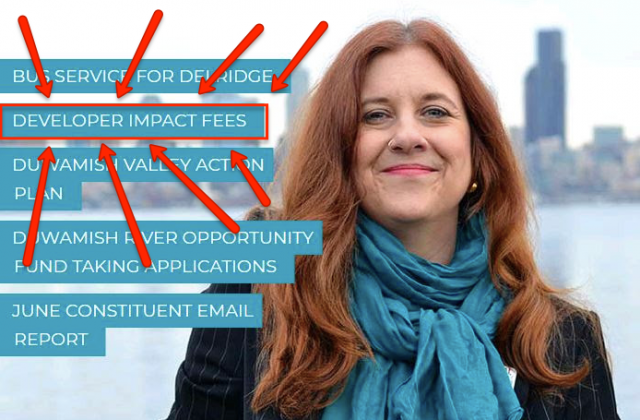Neighborhood MHA Appeal Squashed: What Happened, Why, and What’s Next?
Last week the City’s Hearing Examiner removed the last barrier for citywide implementation of the City’s Mandatory Housing Affordability (MHA) scheme by finding against neighborhood groups that had appealed implementation of MHA. Neighborhood groups argued that the City failed to properly review and consider the impacts of MHA. They failed to persuade, so now the City Council can impose the fees everywhere unless a legal challenge is mounted. At this point, it’s worth looking at how we got to MHA in the first place and what might be next (read a short and concise description about, “What’s Wrong with MHA?”)
How did this all start?
All of this started over a decade ago with proposals to expand something called incentive zoning. In the waning days of 2007, a proposal was moving around City Hall that would have expanded the incentive zoning program, something one lawyer at the time called “zoning for sale;” developers would pay a fee for each additional square foot granted by the program and the money would go to non-profit housing developers. At that time I was just finishing up a stint on City Council staff. But even though we never dealt with the issue, it would come back.
For the next seven years, the fees became the central point of contention in debates about land use in downtown and South Lake Union, with non-profits and some politicians wanting higher fees and developers arguing that higher fees would be a disincentive to participating. Mostly, the fight was between those who thought billionaire Paul Allen was getting away with something and needed to make less money (preferably by giving it to non-profits with fees) and others who viewed the growth in South Lake Union as positive.
But the fight over how much to charge was limited to downtown and South Lake Union. Battles over housing in other neighborhoods was mostly about small-lot single-family development, townhouse and apartment construction, and finally, in 2013 microhousing. As the economy heated up, hiring and growth ramped up, so did the rhetoric about “greed” and “ugly buildings.” In those days, affordability was brought up as one of many issues, but the word and concept grew in repetition and volume as prices rose with increasing demand.
By the time I took on running Seattle For Growth full time in 2014, and seven years after the first rounds of discussion on incentive zoning, we’d had a massive recession caused by a housing bubble and a subsequent recovery. In fact, the market was booming and demand pressures were stoking interest in production of all kinds of housing and innovation in creating supply, especially creating smaller, less expensive housing options.
With rising prices and more construction there also came the election of Kshama Sawant, something that seemed very unlikely just the year before. Her election would turn the volume way up on the noise about rising prices and for interventions like rent control. This pressure from the left would begin to drive the discussion, but for most of 2014 the left was focused on minimum wage, and angry neighbors were pushing more limits on housing types and resisting density.
At the end of 2014 the neighbors had completed a rout of housing that had begun in 2011 when the Council, led by Mike O’Brien, killed the idea of retail in low-rise neighborhoods. Set back by modest upzones in Roosevelt but encouraged by the win on retail, the neighbors shouted down reasonable proposals to regulate small-lot housing in single-family neighborhoods and microhousing. I couldn’t get larger developers interested in turning their fire on the Council to stop this. I was told, “it isn’t our issue,” even though many of the employees moving to Seattle were looking for new, small, and cheaper units.
At the end of that year, seemingly frustrated by the logic of our arguments the City Council shifted on incentive zoning. We had always maintained that incentive zoning was no incentive; charging for additional square footage for housing just added risk and expense that discouraged additional building. It was true, only about a third of eligible projects “took” the incentive. Incentive zoning was legal, but it didn’t work. This meant less money for non-profits. Would the Council lower the price for additional density?
When confronted with the reality that the incentive zoning scheme wasn’t working, Councilmember Mike O’Brien proposed a tax on the development of every square foot of new development in the city to shake out cash for non-profits. This scheme was called the “linkage fee” and we called it the “linkage tax.” This rattled larger developers, especially Vulcan, and a group was formed to oppose the linkage tax. A letter from a bunch of land use attorneyswas written warning that a major lawsuit was possible.
The birth of a “crisis”
At this point, with small-lots and microhousing dead, angry neighbors and lefties fresh from wins on minimum wage began to turn their attention on the linkage idea. It’s important to remember that at this point damaging legislation on housing had been opposed but successful. We filed an appeal of legislation proposed by then Councilmember Sally Clark that deliberately reduced the potential for more housing production in Seattle’s low-rise zone. We did this on our own, with no support from larger developers. We failed.
I repeatedly made the case then that the Council had shifted far to the left or that it had at least realized that they could score political points at the expense of “developers” with little consequence. Housing was either viewed as an “impact,” the source of huge, undeserved profits by corporate developers, or both. View blockage, light and air, and tree protection red herrings merged with social justice claims: more new market rate housing makes single-family neighbors feel bad and it also displaces and harms poor people. More housing means higher prices!
One example of how far things had gone is worth remembering. At some point in rationalizing the imposition of fees as high as $10 or $20 a square foot for all new housing and commercial development, the City trotted out figures that we would later successfully dispute but that reassured the Council that the housing problem was insanely huge. The City staff suggested that Seattle needed 60,000 to 90,000 units of affordable housing to address the cost burden of existing households. This inspired a letter from mostly conservative Councilmembers Bagshaw and Rasmussen suggesting that the City needed to build 6,000 to 9,000 units per year for ten years! Where was the money going to come from? We are in a crisis! They said,
To reach 60,000 – 85,000 units, we must increase our supply by over 6,000-8,500 units of affordable housing annually for the next ten years if we are to make room for the people who want to live and work in our community. If we want to extend that period to twenty years, we need 3,000-4000+ units annually to reach our goal. This will require new approaches.
The City’s numbers proved to be bogus. After we pointed out that they didn’t bother to count all the existing set aside units and microhousing they lowered their numbers – back in 2015 – to something more like 26,000 households, a number that is still cited to this day. As I pointed out in a post a while ago,
Someone forgot to remind themselves that, for example, for the period between 2005 and 2012, housing production in Seattle totaled 29,330 units or, 4,190 units per year.


This was the frenzy unfolding in 2015 and over that summer when the Mayor Murray – who had indicated he had no problem imposing a linkage tax – convened something called the Housing Affordability and Livability Agenda (HALA) Committee. The notion at the time was that this group would do what the committee convened on the minimum wage would do, bargain over the linkage tax and come up with some kind of compromise. Advice from people in that process was that the Mayor would lock people in a room, pound his fist on the table, stomp around, and shout and try to force a “solution.”
HALA, the “Grand Bargain,” and a “crisis” becomes a slow motion disaster
Right now might was well be the time to make a reference to the Trojan Horse. How sad for people that have quit reading at this point to miss out! As Barbara Tuchman writes in her essential March of Folly,
Troy falls at last after ten years of futile, indecisive, noble, mean, tricky, bitter, jealous and only occasionally heroic battle. As the culminating instrumentality for the fall, the story brings in the Wooden Horse. The episode of the Horse exemplifies policy pursued contrary to self-interest — in the face of urgent warning and a feasible alternative. Occurring in this earliest chronicle of Western man, it suggests that such pursuit is an old and inherent human habit.
Why would the leaders of Troy believe that the Greeks had grown tired of fighting, had gone home, and left the big hollow wooden horse as an offering for their wrong doing? Because they were exhausted. Tired from defending their city from a relentless siege. Why would anyone agree to an illegal mandate to pay more fees after opposing voluntary fees? People were tired and big developers thought this would be the end. Wheeling the Trojan Horse of mandated fees into the code would end the war, non-profits would be happy with their cash, and life would go on.
Remember, by 2015 the battle over housing had been raging off and on for the better part of a decade. I was personally exhausted even back then. We’d made every rational argument that more housing was good for lower prices, for the environment, for transit, for jobs, for tax revenue, and for people with less money. Each time we were met with stiff and stubborn resistance, sketchy data, and politics: someone needs to be punished. All this arguing took place in committee meetings, council offices, comment sections, and in person. It was ugly even back then.
By now there were two groups that could say they represented developers, the group of larger developers assembled by Vulcan and Seattle For Growth. I was deliberately excluded from the HALA discussions, even though our group represented arguably the people that build most of the housing in the City. But at the time, it seemed to make sense for me to sit it out; it allowed me to either agree with the outcome or oppose it from the outside. I did what I could, sending articles and emails often to the committee.
In the end what emerged was a deal and a myth, a myth as strong as the one described in the Aeneid. The deal that emerged on fees was between large developers in downtown and South Lake Union who would pay into the existing incentive zoning program for additional square feet on existing proposed projects, and then the City would come up with “modest” upzones and charge fees on every square foot of new housing in the city. This was called the “Grand Bargain,” and is frequently and constantly still called to this day, HALA. This is the myth. Vulcan even paid for signs and stickers that say “HALA Yes” and funded a group called Seattle For Everyone to push it.
Most of the interesting ideas in the HALA report were ignored and the Grand Bargain, now called MHA, would come to absorb the attention of the City and staff and everyone else for the next three years. Throughout this time, no sustained discussion was had in the press or media about the numbers behind the proposal. The old 26,000 cost burdened number has never been revised or updated, there’s been no analysis of the costs of producing non-profit housing and how much could be realistically produced with fees and when. That number was uncritically used to rationalize the so-called “Head Tax.” And the story of HALA became about angry neighbors opposed to density and “urbanists” cheerleading the MHA proposal, mostly because of the fact that neighbors opposed it.
Weirdly, a group of people emerged from the HALA discussion who began to relentlessly pick fights with single-family neighbors about upzoning single-family neighborhoods. This happened when the HALA recommendations were mischaracterized in a Danny Westneat column in the Seattle Times as some kind of single-family roll back. It wasn’t. Yet single-family neighbors made a lot of noise and the Mayor said he’d leave single-family alone. Incensed, some lashed out at single-family neighbors as racist. I watched this with wonder; those very neighbors had done most of the damage. Now, with it too late to save small-lot, mircrohousing, and preserve the low-rise zones there was an anti-single-family mob supporting MHA while the angry neighbor mob was opposing it.
The false narrative and the future
Lost in all this too, was any study or response of what MHA would do to housing production. I personally over the years have made pitch after pitch and plea after plea to consider the costs in production of fees that will be very significant. Mostly, I’ve been treated like Agent Mulder in the X Files. I think that this is partially because my story is complicated. Most people have quit reading by now. The story has lots of twists and turns. Developers and builders are busy closing deals and trying to create housing in an environment that has become less and less hospitable to them and their work. The urbanist crowd, the pro-MHA mob with little immediately at stake for themselves, have been cheerleading the density offered by MHA without any regard to whether the proposal will make things worse. And the angry neighbor mob has opposed the density.
Imagine if Sound Transit proposed a charge on some consumer product related to transportation, say fuel, and had a complex geographic fee schedule. Let’s say the fee was supposed to pay for “affordable transit” including more bus service. One can imagine that the debate would focus on the wider issue of transit capacity and need, but it would also zero in on the question, “What will this do to people paying the fee and what does it actually pay for?”
In today’s debate over MHA, nobody asks these questions. The appeal defeated last week was the latest drama in what has been told as a story about angry neighbors opposing the downsides or more housing in their neighborhood and the Council pushing a policy of “upzones for affordable housing.” How much housing? Where? When? How much density? Will developers build under this new scheme? What happens to market rate housing prices?” There is silence on these key questions, silence that is strange for a policy that will have dramatic and far-reaching effects.
What’s next?
With the neighborhood appeal now squashed, the wooden horse of MHA has just leapt its almost final hurdle, through the main gate of the city walls. The City Council has resisted and ignored any discussion of the inflationary effects of adding thousands of dollars in fees to new housing construction. In fact, they want to add morewith impact fees and they’ve shut off any discussion about reducing the costs of producing market rate and non-profit housing. Executive staff has been high handed and arrogant, dismissing with their silence any notion that MHA won’t solve housing prices but simply make them worse.
The fact is that MHA will stall and kill many projects. We have yet to quantify exactly how many and where. It is a difficult task with each project different from the next. But anecdotally, I hear all the time from builders trying to figure out what the new fees would mean and trying to figure out how they’ll absorb fees. Next, projects can and will work but only when price and rents go up to absorb the fees. This is just a fact. There is no money in development of housing except the money from rent or sales price, period. If costs go up, projects don’t happen or consumers have to pay more.
Finally, remember that letter written by all the big shot attorneys in town? Nothing has changed except the calendar and politics. The proposal is still illegal. You can’t make people include rent-restricted housing and then charge them a fine if they don’t do in exchange for permits. It’s against state law for many of the same reasons argued in that letter against linkage taxes. Here’s what that letter said:
RCW 82.02.020 prohibits the City from imposing a tax or fee on development unless that tax or fee is both voluntary and needed to mitigate a direct impact of a speci2c development. A mandatory linkage fee that applies to most development is neither.
Unless the development community can rouse itself and invest in a legal challenge, the wooden horse of MHA will find it’s way into the code where it will be enshrined in the City’s land use code forever as an entitlement, a stream of cash, for a very powerful interest, non-profit housing developers. I will be Cassandra now: if MHA is not aggressively opposed and soon, the fees will likely never go away. Years from now, when speaking of the challenges to building and financing housing, the discussion will be about fees. And the higher the fees, the higher the rents will need to be, and will inspire even more, higher fees.
This will happen. But will anyone listen to Cassandra now?
Yet frantic pressed we on, our hearts all blind,
and in the consecrated citadel
set up the hateful thing. Cassandra then
from heaven-instructed heart our doom foretold;
but doomed to unbelief were Ilium’s sons.
Our hapless nation on its dying day
flung free o’er streets and shrines the votive flowers.
Vergil. Aeneid. 2.234
The leaders of Troy ignored the warnings. But we do have, as Tuchman points out, a “feasible alternative” to the certain destruction of MHA. We can allow more housing of all kinds in all neighborhoods of Seattle for people of all levels of income. Perhaps had Laocoön and Cassandra filed a legal challenge in Superior Court they could have slowed the progress of the wooden horse long enough for the leaders to think twice. Perhaps we’ll have to leave it up to a judge.
Featured image is The Procession of the Trojan Horse into Troy from about 1760, Giovanni Domenico Tiepolo, The National Gallery, London
Design Review: Comments on Aurora 48 Project
Last night I attended a design review meeting for Aurora 48, a 45 unit project at the corner of 47th and Aurora in Fremont. Big issues brought up by one person was parking — the project has 16 required parking spots — and the impact of Mandatory Housing Affordability (MHA), which puzzles the board. As the chair of the board said, there is “precious little we can do” about parking. I think that’s good. Parking never has and shouldn’t be part of design review. As for MHA, this board expressed concerns about what it is approving since MHA could add a floor.
The board seemed anxious about reviewing a 40 foot tall building, approving it, but then having it turn into a 50 foot tall building. Even one of the board members said, though, that it doesn’t really matter. At the end, they seemed to come around to agreeing that the regular and MHA versions are affected by the same issues about design and landscaping and relationship to various external elements, none of which would have very much value to the people who will live in the building.
It always amazes me that housing projects get run through such a costly process — costly in time and money — when the code itself is already a gauntlet. After the presentation and comments (mine are below) the board talking about issues of inches and feet — literally a couple feet here and there. In the end, design review is an iterative process at the margins. At best it might slightly improve the appearance of a building; at worst the process just raises the rent. In the end, all the beard stroking and speculating and tweaking of landscaping gets paid for by the people that live there. Would they pay extra for all this “nuance of scale” if they had a choice?
I am Roger Valdez, Director of Seattle For Growth a non-profit advocacy group for more housing of all kinds in all neighborhoods for people of all levels of income. And that’s why I am here, to speak in favor of this project; Aurora 48 is a perfect example of our mission and what we’re for.
In 1991 I lived at 4711 Fremont Avenue North, and while there are more people living in the neighborhood now, able to access local retail, the zoo, the park, and transportation options, it is in many ways much the same as it was back then, a mix of single-family and multifamily homes along with retail.
The new project will give 45 new households a chance to live near frequent transit service along with amenities and some parking for cars and bikes.
Aurora 48 will integrate well with the residential community into the neighborhood that has a mix of housing types, including single-family homes with yards, some single-family homes converted into apartments, townhomes, and larger apartment buildings. The project will also add more pedestrian traffic, more customers for local retail, and provide a range of options from studio to three bedroom homes.
I am not a design professional. But having lived in this neighborhood and worked across the city as a neighborhood activist, as a Neighborhood Development Manager, and now as an advocate for more housing, I can say that this project works; that is it will do its part to provide more options for people to affordably live in our city with access to transit and amenities.
Herbold on Impact Fees: “A purely procedural decision.”
Last week we filed an appeal to the City’s proposed amendment to the Comprehensive Plan (comp plan) to allow impact fees. In order to do what they want to do, charge housing projects fees, the City has to amend the comp plan. With all land use related proposals, including this one, comes a required analysis under the State Environmental Policy Act (SEPA). Such an analysis comes either with an Environmental Impact Statement (EIS) explaining how the proposal would impact the environment and how those impacts would be mitigated, or a Determination of Non-Significance (DNS) asserting that the proposal has “no probable significant adverse environmental impacts,” (WAC 197-11-340(1)). Following our appeal and that of another group, Councilmember Lisa Herbold issued an official eye-roll suggesting that the SEPA review process is nothing more than “a purely procedural decision.” As with most dismissive statements, Herbold’s betrays an arrogance and carelessness typical of the City Council.
In a longer email to constituents, Herbold wistfully lays out the schedule for fees that “would have been” had we not filed the appeal.
We’d planned to, in December 2018, consider 2018 Comprehensive Plan amendments for a transportation impact fee program.
After passage, then from December 2018 to February 2019 the City Council would continue analysis and development of a potential impact fee rate schedule, development of options for credits based on planning geography, and legislation drafting.
Finally, the Council had planned from March to April 2019 to consider legislation implementing a transportation impact fee program.
Sad! Looks like that may not happen after all. The other appeal to the finding of no significance, filed by the office of Jack McCullough, says it best:
The City’s approach turns a blind eye to reality and ignores the requirements of the State Environmental Policy Act (“SEPA”). The City may not take the major and consequential step of amending its Comprehensive Plan without a full analysis of the environmental effects of the Proposal.
What’s ironic is that Herbold celebrates and even proposed legislation to make it easier for neighborhoods to do exactly what we’re doing, forcing more analysis of impacts. For Herbold, when neighborhoods do it, an appeal is all about doing the right thing. When people who produce housing use the process to point out overreach and wide negative environmental impact, it’s just a speed bump in a “purely procedural” decision.
The truth is that by Herbold’s own fuzzy math, increases in prices for housing is a direct cause for homelessness. I even quoted her in the appeal saying that,
Further a recent Zillow study shows that a 5 percent increase in the median rent correlates with a 250 percent increase in homelessness.
Of course this was a sloppy overstatement of the correlation; it’s actually 250 new homeless people for each 5 percent increase in rent. Just forget the fact that such relationships don’t point to a casual relationship but a correlative one. But even if it tracked exactly as Herbold believes I guess she’d also have to believe that somehow the increase in rent that would come from impact fees would some how be exempt from the correlation. But that’s the point. We need to find out what impact these fees would have.
As Herbold says, “the appeal means that we are unable to act in December as planned, but let’s see what the Hearing Examiner has in store for us.” Yes, let’s see.
We’re making the City do the math and show their work. Support us today with a contribution online. Just click below!
Seattle For Growth Appeals Impact Fee Determination
Today Seattle For Growth, an advocacy organization supporting more housing of all kinds in all neighborhoods for people of all levels of income, filed an appeal to the City’s Determination of Non-Significance (DNS) for its proposed changes to the Comprehensive Plan to allow the creation of impact fees on new housing.
“The underlying proposal for impact fees reveals the fundamental incoherence of the the City’s housing policy,” said Roger Valdez, Director of Seattle For Growth. “How is adding to the cost of housing production going to lower prices? It won’t. It will make the problem of housing scarcity worse”
The appeal asks the Hearing Examiner to make the City evaluate the environmental impact of increasing housing prices which would likely force people with less money to live further outside the city generating more car trips and putting more demand on transit.
The appeal also calls out the fact that the proposed projects to receive funding from impact fees are “existing deficiencies;” projects that won’t serve new people moving into the city but people already here. Some of the projects like the new light rail station at Graham Street already have dedicated funding sources.
The City is also planning to charge all new housing a fee per square foot through it’s Mandatory Housing Affordability (MHA) program, a policy that will make many projects infeasible, will raise housing prices to absorb fees, and is very likely against state law.
Finally, the City is piecemealing the environmental review.
“This determination is poorly done and the underlying proposal will just make life harder for people trying to make ends meet in the city,” said Valdez.
For further comment or information contact Roger Valdez at 206-427-7707
Seattle For Growth on San Francisco “Slashing Permit Times:” Find the Eraser
There are a lot of band wagon jumpers calling out costs lately. We’ve been pointing out how costs imposed by regulations, fees, fines, taxes, redundant infrastructure requirements, and myriad other self-imposed barriers to increasing housing supply make housing more expensive for people. What’s fascinating is to watch politicians and think tanks board the band wagon.
In Seattle, many of the people who are now, finally, understanding that more fees, taxes, and charges add to housing prices still stubbornly cling to the “Grand Bargain,” a scheme also known as Mandatory Inclusionary Zoning (MIZ) or Mandatory Housing Affordability (MHA) that will simply add to the layer cake of costs passed on to renters. “Why?” you ask. “Well the density increases and money for affordable housing,” they’d say. Sure. Modest density increases subsidized by renters who will struggle to carry that cost with higher rents.
And in San Francisco, newly elected Mayor London Breed has decided to declare war on slow permitting by creating a whole new bureaucracy for reducing permitting times.
All of this would be just amusing if it wasn’t so dangerous.
Lots of people like to be on the “right side” of the math, especially smart people. But when it comes to the politics they start to squirm. I was asked to comment on Mayor Breed’s new Catch-22 creation — a bureaucracy to eliminate bureaucracy — by the San Francisco Business Times, the Puget Sound Business Journal of the Bay Area. I point out how liberals and progressive’s can’t see the irony in hiring more people to work on slow processing of permits. It’s so obvious it’s sad to have to point it out. But what are we for?
So what’s the answer? Cities need to return to first principles: Housing is not an impact, but a social good. If it’s ugly, has no parking and blocks views, too bad. We need it. If a department wants to leverage new construction as a way to build out its infrastructure, the answer is, “No.” Housing first! More housing, even lots of market-rate housing, means more competition between landlords, not between tenants trying to squeeze into units that are more and more expensive.
Housing isn’t a bad thing, unless you are an suspicious and worried single-family homeowner worried about losing value in your home. When something is scarce it has a higher price. Angry neighbors don’t let their anxiety get in the way of their agenda: slowing and stopping new housing supply. And politicians and think tanks don’t mind making speeches and putting out infographics while doing things that are completely inconsistent with the words and images they are touting, like requiring fees for every square foot of new housing. Saying things about what is right is easy. Doing something about it? That’s tough. You can read the whole article at the San Francisco Business Times web site.
We’ve set up an easy online platform for donations. Like what we’re doing and saying? Want to have a principled voice for increased housing supply? Click on the image below and give. Thank you!








